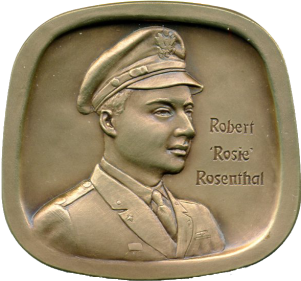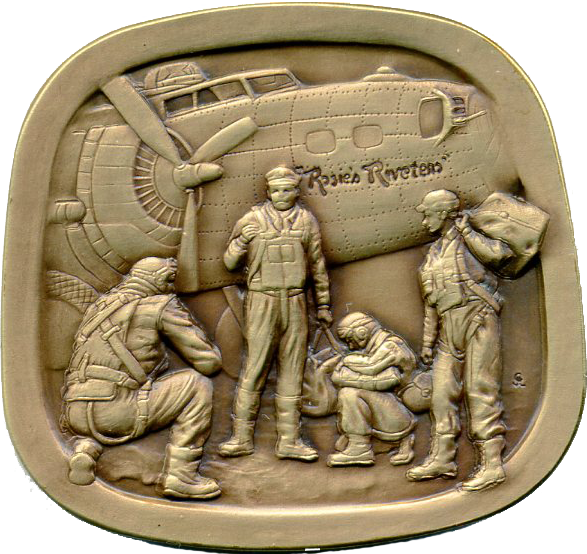 |  |
Robert “Rosie” Rosenthal medal designed by Jim Licaretz, struck by the Highland Mint in quantities of
235 bronze, 58 pure silver, and 25 gold-plated silver. Obverse: Portrait, Robert ‘Rosie’ Rosenthal.
Reverse: Crew of ‘Rosie’s Riveter’s, JL (monogram). 49 x 47 mm.
The day after Pearl Harbor was attacked, Robert “Rosie” Rosenthal enlisted in the U.S. Army. In August 1943, he joined the 418th Squadron of the “Bloody” 100th Bombardment Group, stationed in England. Thirteen B-17s took off for a bombing mission over Munster, but only one returned — aptly named “Rosie’s Riveters” — full of holes and flying on two engines. But in spite of the intercom being out, the oxygen system shot-up and a large ragged hole in the skin of the right wing, they had successfully dropped their bombs over the target.
In March of 1944, Rosie’s Riveters completed its 25th mission, which completed their military service. But Rosie reenlisted, saying “I had to do what I could for as long as I was able.” This was in spite of the fact that 15 missions was the average life of a bomber crew. Later, Rosenthal was made head of the 350th Squadron after the commanding officer was shot down. Intelligence Officer Marvin Bowman found Rosenthal “one of the great figures of the Air Force; a shy, modest, and patriotic gentleman of truly amazing courage and achievement.”
When Rosenthal’s plane went down over Germany in September, he broke his arm and nose — but luckily was rescued by the Free French, to whom he had dropped supplies only a few weeks before. As soon as his arm had healed, Rosie returned to his original (418th) Squadron, and was chosen to lead a mission to Berlin on February 3, 1945.
Even after a direct flak hit put an engine on fire, his blazing Fortress still managed to drop its bombs on the targeted Erkner factory before Rosenthal gave the signal to “Abandon ship.” The rest of the crew parachuted and, after their B-17 had descended to about 1,000 feet, Rosenthal was the last to leave with the ground dangerously close, just before the ship exploded. Fortunately, he was found by Russians, who embraced him and took him to a hospital. This was his 52nd mission; there was to be just one more. Rosie flew his last mission after VE Day, to free prisoners from concentration camps.
Robert “Rosie” Rosenthal was one of the most decorated pilots in the Eighth Air Force. He received 16 decorations, including the Distinguished Service Cross for “extraordinary heroism in connection with military operations against the enemy,” the Silver Star (with cluster) for “gallantry in action,” the Distinguished Flying Cross (with cluster) for “heroism or extraordinary achievement during aerial flight,” the Air Medal (with seven clusters), the Purple Heart (with cluster), plus the British Distinguished Flying Cross and the French Croix de Guerre.
Shortly after VE Day, Rosenthal was back in Germany as an assistant to the United States Prosecutor at the Nuremberg Trials where, among other things, he interrogated Nazi leader Hermann Goering.
Lt. Col. Robert “Rosie” Rosenthal was portrayed by Nate Mann in the in the nine-part Apple TV+ miniseries Masters of the Air (2024).